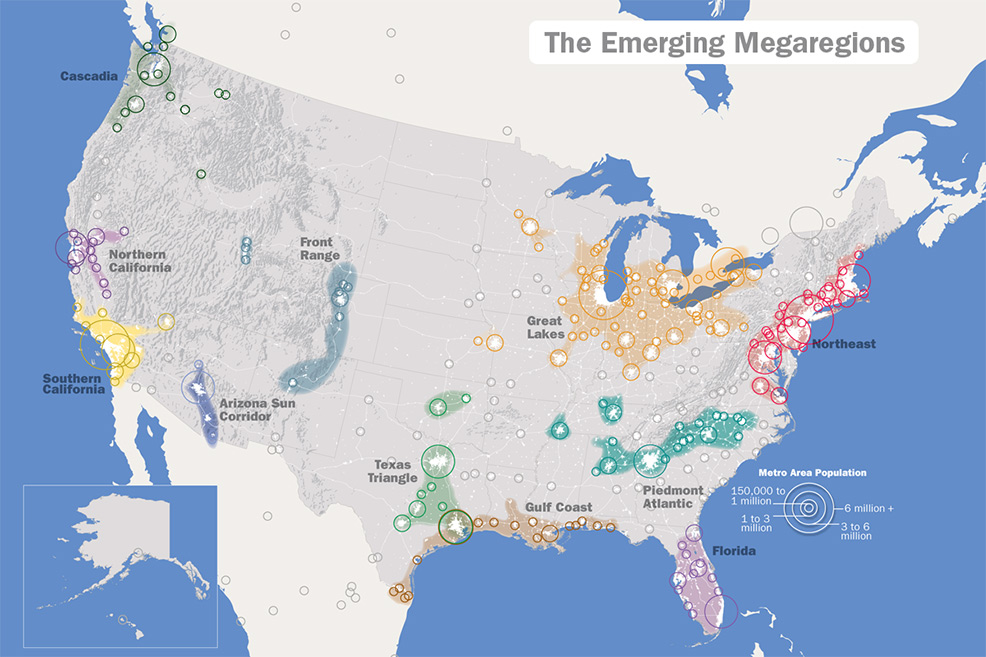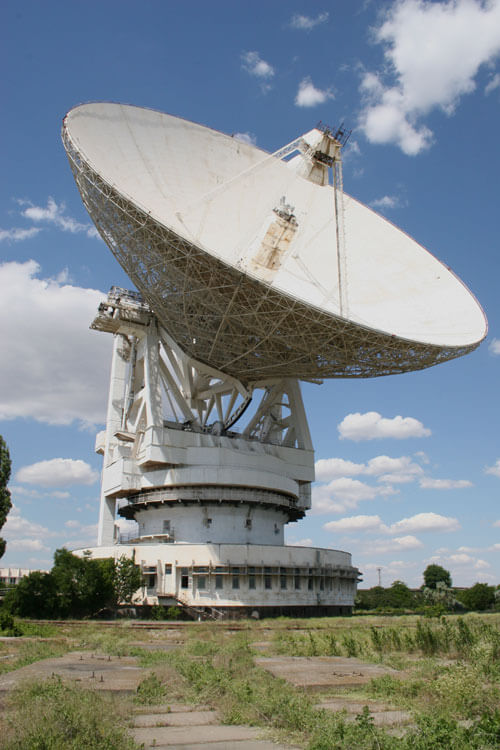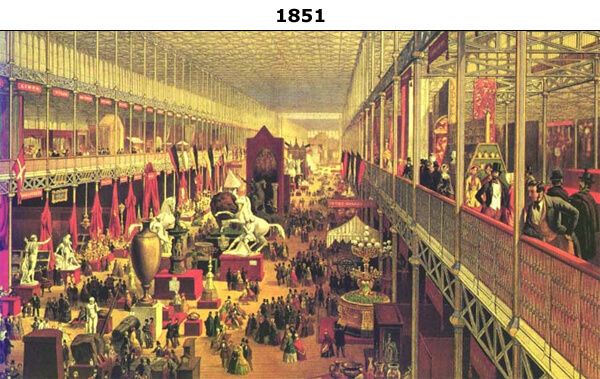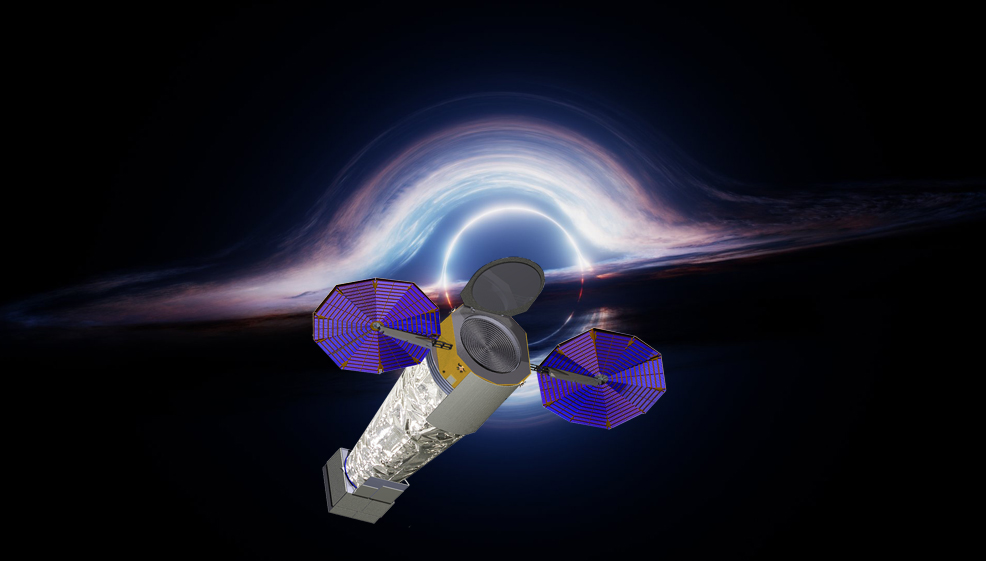
|
|
|
|
|
|
2051
The U.S. population reaches 400 million
By the early 2050s, the population of the United States has reached 400 million.* This follows earlier milestones in 1915 (100 million), 1968 (200 million) and 2007 (300 million). In terms of world rankings, the country remains unchanged from the previous hundred years, in third place behind China and India. However, its share of the global population has decreased from 6.3% in 1950, to 4.6% in 2000 and 3.9% now.
The U.S. in 2051 is more racially and ethnically diverse than ever, white people having declined in number and become a minority.* Those of Hispanic origin have nearly doubled since 2015 and continue to be the fastest growing ethnicity. Black, Asian and other minority groups have also increased, though at a much slower rate than Hispanics.*
The average U.S. citizen is also older, with a far larger percentage of people now aged 65 or above. Even the youngest Gen X-ers are now in their 70s, while the youngest Millennials have entered middle age. The number of centenarians (people aged 100 or over) has risen more than four-fold, from 85,000 in 2015 to 380,000 in 2051.* Alongside a jobs crisis, resulting from automation and technological unemployment, this has put a huge burden on the working-age population – necessitating major reforms in taxation and social welfare. After a number of failed attempts, a form of universal basic income (UBI) has now finally been adopted by most states, though the U.S. was late in this process compared to most other nations in the developed world.
America remains a majority Christian nation, but has seen a nearly 10% increase in those unaffiliated with any organised religion. The Muslim population has increased too, but remains a small segment overall.* In addition, new religions and cults have formed, often based on worship of AI, the 'Singularity' or certain technological niches. Recent advances in mainstream brain-computer interfaces, nanotechnology-based drugs and/or virtual reality have made it easier for leaders to manipulate vulnerable followers, a fact brought into sharper focus by a related government scandal around this time.
As in the rest of the world, urbanisation has continued to increase, with more and more people living in cities. Across the country, enormous "megaregions" have now emerged, producing metropolitan areas that often overlap and stretch across several states.* The biggest of these – Great Lakes – has grown by over 28%, from a population of around 55.5 million in 2010, to more than 71.2 million. The Northeast (encompassing Boston, New York, Philadelphia, Baltimore and Washington, D.C.) has expanded by over 35%, from 52.3 million in 2010 to 70.8 million now. California has seen even faster growth of between 50% (north) and 61% (south) – but remains split into these distinct halves. If combined, the two megaregions would now have a total population of 60.5 million people.

Credit: IrvingPlNYC [CC BY-SA 3.0], from Wikimedia Commons
Most of these megaregions are now linked by high-speed rail, which includes a number of 'hyperloop' routes, breaking down geographical barriers and enabling people to commute from longer distances than in earlier decades. However, America still lacks the kind of extensive networks enjoyed by the likes of Europe and East Asia.
Despite many advances in technology, the U.S. remains a deeply divided country, riven with social and economic problems. The level of income inequality, already a serious concern at the start of the century, has widened even more, as the rate of return on capital continues to exceed the rate of economic growth over the long term.* The first trillionaires have begun to appear in Forbes and other rich lists.* This ever-increasing concentration of wealth in the hands of the upper 1% has further eroded the middle class. Alongside a perpetual cycle of left-right parties offering the same false promises, little has fundamentally changed in American politics. A general apathy has maintained low election turnouts, now averaging just 40% or so (compared with 50% at the start of the 21st century and 60% during the mid-20th).
Recent decades have seen an intensification of the phenomenon known as "truth decay": an increasing disagreement about facts.* This trend has been driven by ongoing polarisation (both political and demographic), as well as the Internet, social media, virtual reality and other technologies, which have accelerated the spread of disinformation. Fake video scenes, for example – indistinguishable from real life, and even made interactive through strong AI – are now so cheap, accessible and easily produced that it has eroded the trust in formerly respected sources of factual information, blurring the line between opinion and fact. All of these trends are further harming civil discourse, causing disengagement and alienation, political paralysis and uncertainty. Americans are routinely bombarded with information overload, often highly personalised and tailored to their individual circumstances in ways that would appear unsettling and surreal to observers from earlier decades. More and more people feel disillusioned by what they see as a hyper-commercialised, intrusive, manipulative society.
With oil, gas and coal no longer playing a significant role in the U.S. economy, the lobbying power of fossil fuel companies has essentially disappeared. However, new lobbyists have taken their place – such as biotech and robotics companies, seeking to change regulations and monopolise their industries. The explosion of genetic upgrades, implants, beauty treatments and other personal tech has become yet another driver of inequality.
The impact of these various trends has been felt most strongly in the southern 'Bible Belt' states. These are hampered by debt and poor economic growth, exacerbated by worsening environmental conditions.* Many people are now flocking to the north, which is more politically stable. Some of those already living in the north are moving into Canada, which has even better long-term prospects. The U.S. population, as a whole, continues to increase for the rest of the century, though at a slower rate than before.
An interstellar radio message arrives at Gliese 777
The Yevpatoria RT-70, located at the Center for Deep Space Communications in Ukraine, was among the largest radio telescopes in the world, with a 70m antenna diameter. On 1st July 1999, it beamed a noise-resistant message named "Cosmic Call 1" into space. This was sent towards Gliese 777, a yellow subgiant star, 52 light-years away in the constellation of Cygnus. At least two extrasolar planets were known to be present in this system. In April 2051, the message arrives at its destination, for any potential alien civilisations to hear and decode it.

Credit: S. Korotkiy
Britain holds its centennial national exhibition
A centennial national exhibition is held in the UK, in keeping with the precedent set by the Great Exhibition of 1851* and the 1951 Festival of Britain.* The opening ceremony is attended by King William V, now aged 69.


UK vehicle plates run out of numbers
The UK first introduced vehicle number plates on 1st January 1904, as part of the Motor Car Act. This law required all motor vehicles to be entered on an official vehicle register, and to carry alphanumeric plates. The government passed the Act in order that vehicles could be easily traced in the event of an accident, contravention of the law or any other incident.
The original system had a one or two-letter county code, followed by a sequence number between 1 and 9,999, e.g., AH72. The available codes began to run out after a few decades, necessitating a new system in 1932. This placed a serial letter before the code, but had sequence numbers run only to 999. Another new scheme emerged in 1963, maintaining three letters but with a fourth as an age identifier at the end, e.g. an "A" suffix for 1963, "B" for 1964, etc. A lack of combinations led to the Prefix system beginning in 1983, which simply moved the age identifier to the start, e.g., A21 BCD.
The UK introduced a fifth system on 1st September 2001. This consisted of two letters identifying the region of registration, two numbers denoting the age (changing twice a year), and three random letters, e.g., BD51 SMR.
For plates issued between March and August, the age identifier would be the last two digits of the year (e.g., '21' for 2021). For plates issued between September and February of the following year, the age identifier would be the last two digits of the year plus 50 (e.g., '71' for plates issued between September 2021 and February 2022). These combinations finally run out during 2051,* requiring the introduction of a sixth vehicle registration system.

Credit: Cnbrb & ZElsb, CC BY-SA 4.0, via Wikimedia Commons
The Suburban Rail Loop is operational in Melbourne
The Suburban Rail Loop is Australia's largest ever transport project. It consists of a 90 km (56 mi) line running through suburban Melbourne and surrounding the central business district (CBD). The loop is designed to help commuters connect easily to major suburban hubs and amenities such as hospitals, shopping centres, universities, and the airport. The service connects almost all existing railway lines via one new route through middle suburbs, thus removing the necessity to travel into the city and out again as per the older hub and spoke rail network.
The line connects the existing station at Cheltenham with other existing stations at Clayton, Glen Waverley, Box Hill, Heidelberg, Reservoir, Fawkner, Broadmeadows, Sunshine and Werribee. It also links to new stations, built in areas that were long promised rail connections, including Monash University, Burwood, Doncaster, Bundoora and Melbourne Airport.
The Suburban Rail Loop was first proposed in August 2018 at a cost of AU$50 billion and received strong public support. Like many government projects, however, it inevitably went over budget.* Construction started by 2022, with sections progressively opening. By the early 2050s, the full line is operational and handling 400,000 passengers a day – relieving pressure on existing city-bound trains, while also taking 200,000 vehicles off congested roads.**

Launch of the X-ray Great Observatory
The X-ray Great Observatory is the third and final project in a trio of long-term, next-generation space telescopes developed by NASA. It follows the earlier Habitable Worlds Observatory (HWO) and Far-Infrared (FIR) Great Observatory launched in 2041 and 2047, respectively. Its completion means that astronomers now have broad coverage of the electromagnetic spectrum in a way that resembles the revolutionary leap in capabilities offered by the Hubble, Spitzer and Chandra space telescopes.
An earlier concept, the Lynx X-ray Observatory,* had been proposed during the 2020 Astronomy and Astrophysics Decadal Survey. Elements of that design would later appear in a finalised version, known as the X-ray Great Observatory. Following 30 years of research and development,* the spacecraft is now a reality and in operation at the L2 Sun-Earth Lagrange point, around 1.5 million km from Earth.
The X-ray Great Observatory is by far the most powerful telescope of its kind ever built, enabling orders of magnitude improvements. It provides a 100-fold increase in sensitivity, 800 times the survey speed, and 16 times the field of view compared with NASA's previous flagship X-ray space telescope, Chandra. Alongside its mirror assembly (containing 12 concentric meta-shells, vs. 8 for Chandra) are three state-of-the-art instruments – a High Definition X-ray Imager, Microcalorimeter, and Grating Spectrometer.*
Gas hotter than a few hundred thousand Kelvin shines brightest in X-rays. The main areas of study are therefore black hole accretion physics, the large-scale structure of the Universe, galaxy formation and evolution, and stellar life cycles. Some of the earliest known black holes are observed, and matter falling onto these objects is detectable in exquisite detail. Data from these interactions can provide clues as to why supermassive black holes in the very early Universe grew to more than a billion solar masses in such a brief period of time. New insights are also provided into Sagittarius A* at the centre of our own Milky Way galaxy.
Many previously hidden neutron stars are revealed by the observatory's extreme sensitivity. Its microcalorimeter can also generate 3D maps of dozens of supernova remnants, including those in the Large and Small Magellanic Clouds, the largest of the satellite dwarf galaxies orbiting the Milky Way.
Studies of exoplanets are also possible. The observatory can detect X-ray emissions as markers of young stars in active star-forming regions, study stellar coronae in detail, and determine the impact of stellar X-ray and extreme ultraviolet flux and winds on the habitability of planetary systems.
Hyper-sharp images are possible thanks to a new optics design, which can maintain sub-arcsecond spatial resolution out to ten arcminutes. While Chandra required almost nine days to photograph a supernova remnant, the X-ray Great observatory can produce even sharper and more stunning images, over a much larger field of view, in just a few hours. Like the other New Great Observatories, it remains in service until the 2070s.*

« 2050 |
⇡ Back to top ⇡ |
2052 » |
If you enjoy our content, please consider sharing it:
References
1 United States population, 2000-2060, Future Timeline:
https://www.futuretimeline.net/data-trends/4.htm
Accessed 23rd June 2018.
2 See 2042.
3 What America will look like in 2050, in 4 charts, The Washington Post:
https://www.washingtonpost.com/news/the-fix/wp/2015/04/03/what-america-will-look-like-in-2050-less-christian-less-white-more-gray/?utm_term=.aea493f45896
Accessed 23rd June 2018.
4 World's centenarian population projected to grow eightfold by 2050, Pew Research Center:
http://www.pewresearch.org/fact-tank/2016/04/21/worlds-centenarian-population-projected-to-grow-eightfold-by-2050/
Accessed 23rd June 2018.
5 What America will look like in 2050, in 4 charts, The Washington Post:
https://www.washingtonpost.com/news/the-fix/wp/2015/04/03/what-america-will-look-like-in-2050-less-christian-less-white-more-gray/?utm_term=.aea493f45896
Accessed 23rd June 2018.
6 Megaregions, America 2050:
http://www.america2050.org/content/megaregions.html
Accessed 23rd June 2018.
7 Chart of the Week: U.S. middle class no longer the world's richest, Pew Research Center:
http://www.pewresearch.org/fact-tank/2014/04/25/chart-of-the-week-u-s-middle-class-no-longer-the-worlds-richest/
Accessed 23rd June 2018.
8 See 2039.
9 Truth decay, RAND Corporation:
https://www.rand.org/pubs/research_reports/RR2314.html
Accessed 23rd June 2018.
10 Climate change will increase inequality in the USA, Future Timeline Blog:
https://www.futuretimeline.net/blog/2017/07/1.htm
Accessed 23rd June 2018.
11 The Great Exhibition, Wikipedia:
http://en.wikipedia.org/wiki/The_Great_Exhibition
Accessed 6th May 2012.
12 Festival of Britain, Wikipedia:
http://en.wikipedia.org/wiki/Festival_of_Britain
Accessed 6th May 2012.
13 How to read number plates, The AA:
https://www.theaa.com/car-buying/number-plates
Accessed 24th July 2023.
14 Victoria pledges $50b suburban rail line, Macleay Argus:
https://www.macleayargus.com.au/story/5611082/victoria-pledges-50b-suburban-rail-line/?cs=9397
Accessed 2nd September 2018.
15 Victoria's Big Build - Suburban Rail Loop, Official Victorian Government website:
https://bigbuild.vic.gov.au/projects/suburban-rail-loop
Accessed 2nd September 2018.
16 Suburban Rail Loop – new underground rail connecting Melbourne's suburbs, YouTube:
https://www.youtube.com/watch?v=9RHW0k8ngs0
Accessed 2nd September 2018.
17 The X-ray Observatory, Official website:
https://www.greatobservatories.org/xray
Accessed 2nd February 2023.
18 NASA prepares next steps in development of future large space telescope, SpaceNews:
https://spacenews.com/nasa-prepares-next-steps-in-development
Accessed 2nd February 2023.
19 Lynx X-ray Observatory, Official website:
https://www.lynxobservatory.com/
Accessed 2nd February 2023.
20 'Great observatories' – the next generation of NASA's space telescopes, and their impact on the next century of observational astronomy, Physics World:
https://physicsworld.com/a/great-observatories-the-next-generation
Accessed 2nd February 2023.
![[+]](https://www.futuretimeline.net/images/buttons/expand-symbol.gif)






